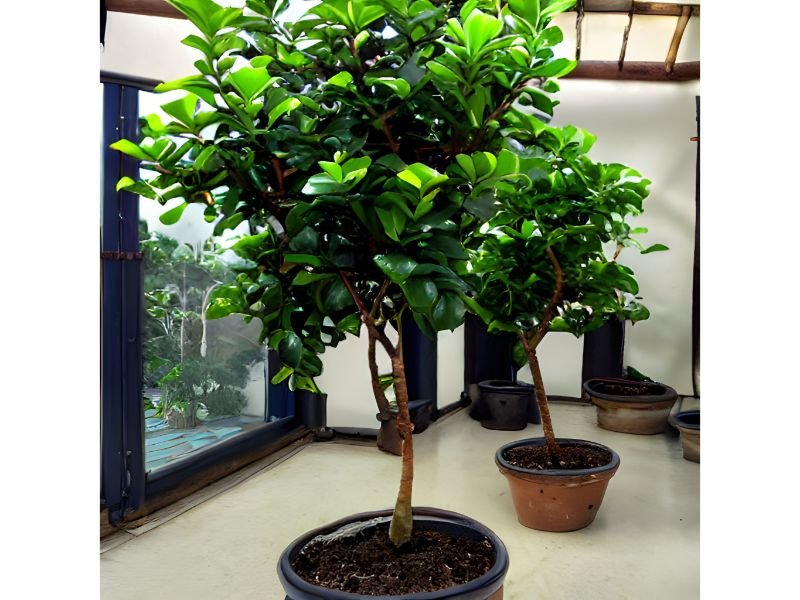Ficus robusta, also known as the robusta fig or Indian rubber plant, is a species of fig tree native to India and Southeast Asia. It is a large, evergreen tree that can grow up to 50 feet tall and has dark green, glossy leaves. The tree is known for its thick, rubber-like sap, which is used in a variety of products including rubber, glue, and traditional medicines. Ficus Robusta as a Houseplant is a popular choice due to its ability to thrive in low light conditions and its ability to purify the air.

Table of Contents
Benefits of growing Ficus robusta as a houseplant
Ability to thrive in low light conditions
There are many benefits to growing Ficus robusta as a houseplant. One of the main advantages is its ability to thrive in low-light conditions. Ficus robusta can tolerate a wide range of lighting conditions, from full sun to low, indirect light. This makes it a great choice for homes and offices with limited natural light.
Ability to purify indoor air
In addition to its low light tolerance, Ficus robusta is also known for its ability to purify indoor air. The plant has been shown to remove volatile organic compounds (VOCs) from the air, which can help improve air quality and reduce the risk of indoor air pollution. This is especially beneficial for people who live in urban areas or who are exposed to high levels of pollution.
Low maintenance requirements
Another benefit of Ficus robusta is its low maintenance requirements. The plant is relatively easy to care for and does not require frequent watering or fertilization. It is also resistant to pests and diseases, making it a low-maintenance addition to your indoor plant collection.
Attractive appearance and versatility in home decor

In addition to its practical advantages, Ficus robusta is also a beautiful and versatile plant that can add a touch of greenery to any room. The glossy, dark green leaves of the plant are attractive and can complement a variety of home decor styles. Ficus robusta can be grown as a standalone plant or used in combination with other plants to create a lush, tropical look.
Tips for caring for Ficus robusta as a houseplant
Optimal light and temperature conditions
To care for Ficus robusta, it is important to provide the plant with optimal light and temperature conditions. The plant prefers bright, indirect light and should be protected from direct sunlight, which can cause the leaves to yellow and fade. Ficus robusta should also be kept in a warm, humid environment with temperatures between 60 and 75 degrees Fahrenheit.
Proper watering and fertilization
In terms of watering and fertilization, Ficus robusta should be watered when the top inch of the soil feels dry to the touch. The plant prefers evenly moist soil, but it is important to avoid over-watering, which can lead to root rot. Ficus robusta should also be fertilized once a month during the growing season with a balanced, water-soluble fertilizer.
Pest control and potential challenges
Ficus robusta is generally resistant to pests and diseases, but it can still be prone to certain issues. Here are some potential pests and challenges to be aware of when caring for Ficus robusta:
- Spider mites: These tiny pests can be a problem for Ficus robusta and other indoor plants. They are most commonly found on the undersides of leaves and can cause yellowing and stippling. To control spider mites, you can try misting the plant with water, using a neem oil or insecticidal soap solution, or applying a miticide.
- Mealybugs: These small, white insects can also be a problem for Ficus robusta. They tend to cluster on the stems and leaves of the plant and can cause leaf yellowing and premature leaf drop. To control mealybugs, you can try removing them manually, using a neem oil or insecticidal soap solution, or applying a systemic insecticide.
- Root rot: Ficus robusta is susceptible to root rot if it is overwatered or if the soil is too wet. Signs of root rot include yellowing leaves, wilting, and a rotten smell coming from the soil. To prevent root rot, be sure to water the plant only when the top inch of soil feels dry to the touch, and make sure the plant is planted in well-draining soil. If the plant is already suffering from root rot, you may need to remove the affected roots and repot the plant in fresh soil.
- Leaf drop: Ficus robusta may experience leaf drop if it is subjected to sudden changes in light or temperature, or if it is not getting enough water or nutrients. To prevent leaf drop, try to maintain consistent light and temperature conditions for the plant and make sure it is getting adequate water and fertilization.
By being aware of these potential challenges and taking steps to prevent them, you can help your Ficus robusta stay healthy and thriving.
Recap of the benefits of Ficus robusta as a houseplant
Overall, Ficus robusta is a great choice for anyone looking to add a low-maintenance, air-purifying plant to their home or office. Its ability to thrive in low light conditions, its attractive appearance, and its versatility in home decor make it a practical and attractive choice.

Gardening is my passion and growing plants indoors has always been a stress relief for me. Grow a banana tree in my apartment once (although failed to produce bananas).






